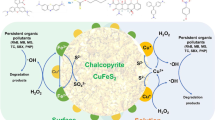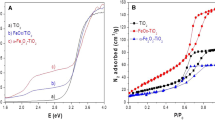Abstract
A new method for bisphenol A (BPA) degradation in aqueous solution was developed. The characteristics of BPA degradation in a heterogeneous ultraviolet (UV)/Fenton reaction catalyzed by FeCo2O4/TiO2/graphite oxide (GO) were studied. The properties of the synthesized catalysts were characterized using scanning electron microscopy, X-ray diffraction, and vibrating sample magnetometry. FeCo2O4 and TiO2 were grown as spherical shape, rough surface, and relatively uniform on the surface of GO (FeCo2O4/TiO2/GO). Batch tests were conducted to evaluate the effects of the initial pH, FeCo2O4/TiO2/GO dosage, and H2O2 concentration on BPA degradation. In a system with 0.5 g L−1 of FeCo2O4/TiO2/GO and 10 mmol L−1 of H2O2, approximately 90 % of BPA (20 mg L−1) was degraded within 240 min of UV irradiation at pH 6.0. The reused FeCo2O4/TiO2/GO catalyst retained its activity after three cycles, which indicates that it is stable and reusable. The heterogeneous UV/Fenton reaction catalyzed by FeCo2O4/TiO2/GO is a promising advanced oxidation technology for treating wastewater that contains BPA.











Similar content being viewed by others
References
Bizani E, Lambropoulou D, Fytianos K, Poulios I (2014) Photocatalytic degradation of molinate in aqueous solutions. Environ Sci Pollut R 21:12294–12304. doi:10.1007/s11356-014-3086-2
Chen J, Zhu L (2007) UV-Fenton discolouration and mineralization of Orange II over hydroxyl-Fe-pillared bentonite. J. Photochem. Photobiol., A 188:56–64. doi:10.1016/j.jphotochem.2006.11.018
Chen Q, Ji F, Liu T, Yan P, Guan W, Xu X (2013) Synergistic effect of bifunctional Co–TiO2 catalyst on degradation of rhodamine B: Fenton-photo hybrid process. Chem Eng J 229:57–65
Costa RCC et al. (2006) Novel active heterogeneous Fenton system based on Fe3-xMxO4 (Fe, Co, Mn, Ni): the role of M2+ species on the reactivity towards H2O2 reactions. J Hazard Mater 129:171–178. doi:10.1016/j.jhazmat.2005.08.028
Daneshvar N, Salari D, Khataee AR (2003) Photocatalytic degradation of azo dye acid red 14 in water: investigation of the effect of operational parameters. J Photochem Photobiol, A 157:111–116
De Laat J, Gallard H (1999) Catalytic decomposition of hydrogen peroxide by Fe(III) in homogeneous aqueous solution: mechanism and kinetic modeling. Environ Sci Technol 33:2726–2732. doi:10.1021/es981171v
Guo C, Ge M, Liu L, Gao G, Feng Y, Wang Y (2009) Directed synthesis of mesoporous TiO2 microspheres: catalysts and their photocatalysis for bisphenol a degradation. Environ Sci Technol 44:419–425
He H, Gao C (2010) Supraparamagnetic, conductive, and Processable multifunctional graphene Nanosheets coated with high-density Fe3O4 nanoparticles. Acs Appl Mater Inter 2:3201–3210. doi:10.1021/am100673g
Herney-Ramirez J, Vicente MA, Madeira LM (2010) Heterogeneous photo-Fenton oxidation with pillared clay-based catalysts for wastewater treatment: a review. Appl Catal, B 98:10–26. doi:10.1016/j.apcatb.2010.05.004
Hua Z, Ma W, Bai X, Feng R, Yu L, Zhang X, Dai Z (2014) Heterogeneous Fenton degradation of bisphenol a catalyzed by efficient adsorptive Fe3O4/GO nanocomposites. Environ Sci Pollut R 21:7737–7745. doi:10.1007/s11356-014-2728-8
Hua Z, Zhang X, Bai X, Lv L, Ye Z, Xin H (2015) Nitrogen-doped perovskite-type La2Ti2O7 decorated on graphene composites exhibiting efficient photocatalytic activity toward bisphenol a in water. J Colloid Interf Sci 450:45–53
Huang R, Fang Z, Yan X, Cheng W (2012) Heterogeneous sono-Fenton catalytic degradation of bisphenol a by Fe3O4 magnetic nanoparticles under neutral condition. Chem Eng J 197:242–249. doi:10.1016/j.cej.2012.05.035
Hummers WS Jr, Offeman RE (1958) Preparation of graphitic oxide. J Am Chem Soc 80:1339–1339
Kim HE, Lee J, Lee H, Lee C (2012) Synergistic effects of TiO2 photocatalysis in combination with Fenton-like reactions on oxidation of organic compounds at circumneutral pH. Appl Catal B 115:219–224. doi:10.1016/j.apcatb.2011.12.027
Kim LJ, Jang JW, Park JW (2014) Nano TiO2-functionalized magnetic-cored dendrimer as a photocatalyst. Appl Catal, B 147:973–979. doi:10.1016/j.apcatb.2013.10.024
Klecka GM, Staples CA, Clark KE, van der Hoeven N, Thomas DE, Hentges SG (2009) Exposure analysis of bisphenol a in surface water Systems in North America and Europe. Environ Sci Technol 43:6145–6150. doi:10.1021/es900598e
Kwan WP, Voelker BM (2002) Decomposition of hydrogen peroxide and organic compounds in the presence of dissolved iron and ferrihydrite. Environ Sci Technol 36:1467–1476. doi:10.1021/es011109p
Liang CJ, Bruell CJ, Marley MC, Sperry KL (2003) Thermally activated persulfate oxidation of trichloroethylene (TCE) and 1,1,1-trichloroethane (TCA) in aqueous systems and soil slurries soil sediment. Contam 12:207–228. doi:10.1080/713610970
Liao C, Kannan K (2011) High levels of bisphenol a in paper currencies from several countries, and implications for dermal exposure. Environ Sci Technol 45:6761–6768. doi:10.1021/es200977t
Lin SS, Gurol MD (1998) Catalytic decomposition of hydrogen peroxide on iron oxide: kinetics, mechanism, and implications. Environ Sci Technol 32:1417–1423. doi:10.1021/es970648k
Malato S, Caceres J, Agüera A, Mezcua M, Hernando D, Vial J, Fernández-Alba A (2001) Degradation of imidacloprid in water by photo-Fenton and TiO2 photocatalysis at a solar pilot plant: a comparative study. Environ Sci Technol 35:4359–4366
Nan CM, Bo J, Chow CWK, Chris S (2010) Recent developments in photocatalytic water treatment technology: a review. Water Res 44:2997–3027
Noonan GO, Ackerman LK, Begley TH (2011) Concentration of bisphenol a in highly consumed canned foods on the US market. J Agric Food Chem 59:7178–7185
Oseghe EO, Ndungu PG, Jonnalagadda SB (2015) Synthesis of mesoporous Mn/TiO2 nanocomposites and investigating the photocatalytic properties in aqueous systems. Environ Sci Pollut R 22:211–222
Perez M, Torrades F, Domenech X, Peral J (2002) Fenton and photo-Fenton oxidation of textile effluents. Water Res 36:2703–2710. doi:10.1016/s0043-1354(01)00506-1
Ramirez JH, Maldonado-Hódar FJ, Pérez-Cadenas AF, Moreno-Castilla C, Costa CA, Madeira LM (2007) Azo-dye Orange II degradation by heterogeneous Fenton-like reaction using carbon-Fe catalysts. Appl Catal, B 75:312–323
Sires I, Brillas E (2012) Remediation of water pollution caused by pharmaceutical residues based on electrochemical separation and degradation technologies: a review. Environ Int 40:212–229. doi:10.1016/j.envint.2011.07.012
Soon AN, Hameed B (2013) Degradation of acid blue 29 in visible light radiation using iron modified mesoporous silica as heterogeneous photo-Fenton catalyst. Appl Catal, A 450:96–105
Staples CA, Dorn PB, Klecka GM, O’Block ST, Harris LR (1998) A review of the environmental fate, effects, and exposures of bisphenol A. Chemosphere 36:2149–2173. doi:10.1016/s0045-6535(97)10133-3
Su S, Guo W, Leng Y, Yi C, Ma Z (2013) Heterogeneous activation of Oxone by CoxFe3-xO4 nanocatalysts for degradation of rhodamine B. J Hazard Mater 244:736–742. doi:10.1016/j.jhazmat.2012.11.005
Tryba B, Piszcz M, Grzmil B, Pattek-Janczyk A, Morawski AW (2009) Photodecomposition of dyes on Fe-C-TiO2 photocatalysts under UV radiation supported by photo-Fenton process. J Hazard Mater 162:111–119. doi:10.1016/j.jhazmat.2008.05.057
Utset B, Garcia J, Casado J, Domenech X, Peral J (2000) Replacement of H2O2 by O2 in Fenton and photo-Fenton reactions. Chemosphere 41:1187–1192. doi:10.1016/s0045-6535(00)00011-4
Valizadeh S, Rasoulifard M, Dorraji MS (2014) Modified Fe3O4-hydroxyapatite nanocomposites as heterogeneous catalysts in three UV, Vis and Fenton like degradation systems. Appl Surf Sci 319:358–366
Wei H, Wang E (2008) Fe3O4 magnetic nanoparticles as peroxidase mimetics and their applications in H2O2 and glucose detection. Anal Chem 80:2250–2254. doi:10.1021/ac702203f
Wu C, Liu X, Wei D, Fan J, Wang L (2001) Photosonochemical degradation of phenol in water. Water Res 35:3927–3933
Yang X, Tian P, Zhang C, Deng Y, Xu J, Gong J, Han Y (2013) Au/carbon as Fenton-like catalysts for the oxidative degradation of bisphenol a. Appl Catal, B 134-135:145–152. doi:10.1016/j.apcatb.2013.01.008
Zhang S, Zhao X, Niu H, Shi Y, Cai Y, Jiang G (2009) Superparamagnetic Fe3O4 nanoparticles as catalysts for the catalytic oxidation of phenolic and aniline compounds. J Hazard Mater 167:560–566. doi:10.1016/j.jhazmat.2009.01.024
Zhang Y, Cheng Y, Chen N, Zhou Y, Li B, Gu W, Shi X, Xin Y (2014) Recyclable removal of bisphenol a from aqueous solution by reduced graphene oxide–magnetic nanoparticles: adsorption and desorption. J Colloid Interface Sci 421:85–92
Acknowledgments
The authors gratefully acknowledge the support provided by National Natural Science Foundation of China (Grant No. 51308183), Natural Science Foundation of Jiangsu Province of China (Grant No. BK20130828), the Fundamental Research Funds for the Central Universities (2013B32214), Qing Lan Project, and A Project Funded by the Priority Academic Program Development of Jiangsu Higher Education Institutions.
Author information
Authors and Affiliations
Corresponding author
Additional information
Responsible editor: Vítor Pais Vilar
Rights and permissions
About this article
Cite this article
Bai, X., Lyu, L., Ma, W. et al. Heterogeneous UV/Fenton degradation of bisphenol A catalyzed by synergistic effects of FeCo2O4/TiO2/GO. Environ Sci Pollut Res 23, 22734–22743 (2016). https://doi.org/10.1007/s11356-016-7316-7
Received:
Accepted:
Published:
Issue Date:
DOI: https://doi.org/10.1007/s11356-016-7316-7




